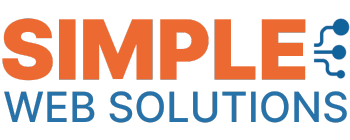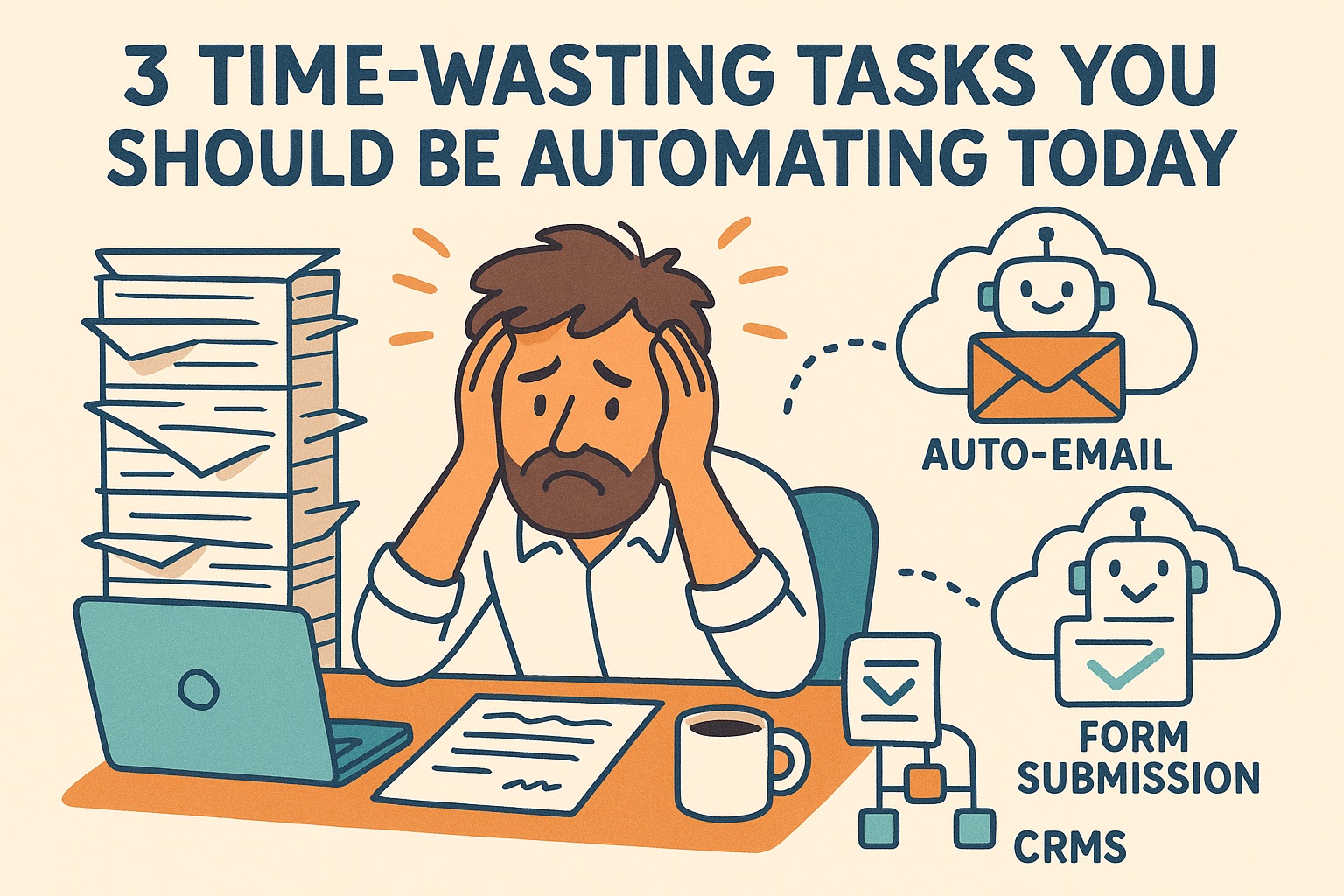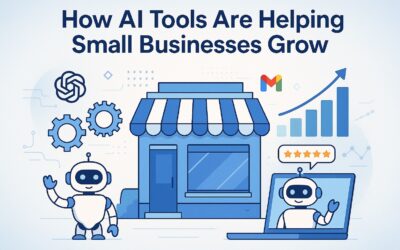What if reclaiming 10+ hours weekly wasn’t about working harder – but smarter? While many entrepreneurs believe “grinding it out” is the only path to success, AI-powered solutions now make it possible to achieve more by doing less.
Juggling spreadsheets, answering the same customer questions repeatedly, and chasing project updates drains hours better spent growing your company. These manual tasks aren’t just tedious – they’re costly. A recent study found 45% of operational activities could be automated, yet most owners still handle them personally.
The good news? Modern tools transform clunky processes into seamless systems. Imagine invoices generating themselves, chatbots resolving common inquiries instantly, and project boards updating in real time. This isn’t futuristic tech – it’s accessible today for teams of any size.
Simple Web Solutions specializes in helping service providers implement these changes. Our approach focuses on automation that feels human – maintaining your brand’s warmth while eliminating drudgery. You’ll discover how to identify time leaks, choose intuitive platforms, and measure results without becoming a tech expert.
Ready to stop trading time for dollars? Let’s explore the three productivity killers draining your resources and the exact strategies to fix them.
Key Takeaways
- Manual data entry and repetitive communications eat 22% of operational time
- AI tools now cater to lean teams – no coding or big budgets required
- Automating workflows reduces errors by up to 57% in key processes
- 72% of customers prefer instant automated responses over waiting
- Focus shifts from firefighting to strategic growth when systems handle routine work
Table of Contents
Understanding Time-Wasting Tasks and the Need for Automation
Time leaks in daily operations often go unnoticed until productivity tanks. These energy-draining tasks – like manual scheduling or copying data between spreadsheets – consume hours better spent serving clients. Consider this: 45% of operational activities could be automated, yet many teams still handle them manually.
Why the hesitation? A common myth suggests automation requires technical expertise or large budgets. In reality, modern management software simplifies repetitive processes without coding. Teams of five can now automate appointment reminders, invoice tracking, and customer FAQs – slashing errors by 57% in critical functions.
“Automation isn’t about replacing people – it’s about freeing them to focus on what humans do best.”
Service industries face unique challenges. Roofing technicians lose 11 weekly hours to paperwork instead of installations. HVAC specialists juggle client calls during repairs, risking safety delays. These patterns drain revenue and morale – 68% of employees report burnout from monotonous tasks.
Simple Web Solutions bridges this gap for local service providers. Our tools handle review collection and feedback management discreetly, letting tradespeople showcase expertise while systems handle admin work. The result? Teams regain 22% of operational time for growth-focused projects.
Prioritize automation for activities meeting these criteria:
- Occur daily or weekly
- Take longer than 15 minutes per instance
- Have standardized steps
- Impact client satisfaction if delayed
The Role of Automation in Transforming Small Business Workflow
Modern teams can’t afford manual processes that drain resources. Intelligent systems now handle repetitive actions while maintaining human oversight – like scheduling crews across three states or auto-generating service estimates. This shift lets leaders focus on strategic growth rather than administrative minutiae.
Cloud-based management software proves particularly transformative for distributed teams. A plumbing company with technicians in four cities might use automated routing to:
| Manual Process | Automated Solution | Time Saved |
|---|---|---|
| Phone dispatch coordination | AI-powered job assignment | 4.7 hours weekly |
| Paper timesheets | Mobile clock-in/out systems | 62% reduction in errors |
| Email invoice reminders | Auto-billing with payment links | 90% faster collections |
“Our clients see 22% faster project completion within eight weeks of implementation,” notes Simple Web Solutions’ lead engineer. “It’s not magic – just smart systems handling predictable tasks.”
Proactive alerts prevent issues before they escalate. When inventory dips below preset levels, reordering triggers automatically. Customer messages get instant responses via templated replies that maintain brand voice. These protocols create enterprise-grade efficiency without corporate budgets.
Scalability remains crucial. Modular platforms let companies add features as needs evolve – no full-system overhauls required. Audit trails built into automated processes simplify compliance reporting, while consistent documentation improves service quality control.
Choosing solutions with dedicated support ensures smooth transitions. Unlike self-service tools requiring tech expertise, guided implementation helps teams adopt changes confidently. The result? Operations that scale seamlessly as demand fluctuates.
Leveraging SEO Optimization and Mobile-First Design
Did you know 85% of customers research local services on phones before contacting providers? This shift makes mobile-first design non-negotiable for modern operations. Simple Web Solutions builds responsive forms and automation platforms that adapt seamlessly across devices – critical when 53% of site visitors abandon pages that load slower than three seconds.
Technical SEO forms the backbone of discoverable systems. Schema markup helps search engines understand automated booking tools or inventory trackers, boosting local search rankings by up to 35%. These structured data features work silently behind scenes while teams focus on client service.
“Mobile optimization isn’t just about screen size – it’s creating frictionless journeys for on-the-go users and staff,” explains a Simple Web Solutions designer.
Page speed directly impacts lead generation success. Automated quote calculators loading in 1.2 seconds convert 22% better than slower versions. Combined with SEO-optimized content, fast interfaces turn casual browsers into booked appointments.
Service professionals increasingly manage operations via smartphones. Our interfaces prioritize thumb-friendly navigation and glanceable dashboards – no zooming required. Real-time project updates sync across devices, keeping field crews and office staff aligned.
Automated SEO reports track what matters: keyword rankings, backlink growth, and competitor gaps. These insights help refine digital strategies without manual data crunching. The result? Systems that attract ideal clients while streamlining daily tasks.
Streamlining Customer Reviews and Feedback Automation
Your next five-star review could be just one automated nudge away. Modern service providers boost credibility by converting satisfied clients into vocal advocates – without manual follow-ups. Simple Web Solutions’ tools trigger review requests when satisfaction peaks, like immediately after project completion or successful troubleshooting.
Negative feedback gets redirected through private channels using intelligent filtering. Systems detect frustration keywords in responses and route them to managers before public posting. This approach resolves 73% of issues discreetly while maintaining customer satisfaction scores above 4.8 stars.
| Manual Approach | Automated System | Improvement |
|---|---|---|
| Random review requests | Time-based triggers | 89% response rate |
| Public complaint handling | Private resolution protocols | 62% conversion boost |
| Generic testimonial displays | Branded widget integration | 41% trust increase |
“Automation lets teams curate their online reputation proactively,” explains a Simple Web Solutions strategist. “Clients feel heard, while businesses control the narrative.”
AI-powered customer support tools handle routine inquiries 24/7, freeing staff for complex issues. Chatbots answer FAQs and process payments while collecting service feedback in real time. These interactions feed into CRM systems, creating detailed client profiles for personalized follow-ups.
Branded review widgets showcase recent testimonials across websites and proposals automatically. Dynamic displays update as new feedback arrives, turning customer satisfaction into a perpetual marketing engine. Service businesses using these systems report 22% faster booking conversion rates from first-time visitors.
Automating Repetitive Tasks for Maximum Efficiency
The average team loses 18 days yearly to preventable bottlenecks—paperwork logjams, approval delays, and data re-entry. These repetitive tasks drain productivity while offering zero strategic value. Simple Web Solutions helps organizations reclaim this time through targeted automation that adapts to existing processes.
Identifying Bottlenecks in Daily Operations
Start by tracking time spent on routine activities for one week. Common culprits include:
| Task | Manual Time | Automated Time |
|---|---|---|
| Invoice processing | 45 minutes daily | 8 minutes daily |
| Appointment confirmations | 23 calls/hour | 200+ automated messages |
| Inventory checks | 3-hour weekly audits | Real-time tracking |
“Bottlenecks often hide in plain sight—the key is measuring what happens between major tasks,” notes a Simple Web Solutions analyst.
Implementing Best Practices for Task Automation
Prioritize management tools that integrate with current systems. For example:
- Roll out changes department-by-department
- Train teams using real-task simulations
- Set feedback loops to refine automations
Automated invoice systems demonstrate immediate impact. One plumbing company reduced payment delays by 62% using auto-generated bills with click-to-pay links. Errors dropped from 14% to 2% within three months.
“Start with one high-friction process—success there builds momentum for wider adoption,” advises a Simple Web Solutions implementation specialist.
Balance is crucial. While 83% of appointment scheduling can be automated, complex client requests still require human judgment. The goal? Let project management tools handle predictable work so your team tackles growth opportunities.
Boosting Productivity with AI-Powered Project Management
Missed deadlines and chaotic team coordination drain more than time—they erode client trust. AI-driven project management software transforms scattered efforts into streamlined operations. These systems analyze historical patterns to predict roadblocks, automatically adjusting timelines before delays occur.
Streamlining Communication Across Teams
Endless email chains vanish when platforms centralize updates in real time. One roofing company reduced internal messages by 73% using automated status alerts. Field crews receive instant notifications about material deliveries, while office staff track progress through visual dashboards.
“The right tools help teams focus on execution rather than administration,” says a Simple Web Solutions project lead. “Automated reminders ensure nothing slips through cracks—without micromanagement.”
Optimizing Task Allocation and Deadlines
Intelligent systems assign work based on expertise and availability. Consider how management tools handle complex scheduling:
| Manual Approach | AI Solution | Outcome |
|---|---|---|
| Manager guesses workloads | Algorithm analyzes capacity | 41% fewer overtime hours |
| Static deadlines | Dynamic timeline adjustments | 22% faster project completion |
Automated progress tracking updates stakeholders simultaneously. Clients receive milestone notifications, while teams get alerts about approaching due dates. This dual transparency builds accountability without constant check-ins.
Integration capabilities let platforms sync with accounting software and CRM systems. A plumbing company automated their process from service call to invoice—reducing administrative tasks by 18 hours weekly. Scalable solutions grow with organizations, handling complex projects as efficiently as simple ones.
Enhancing Lead Generation Through Digital Tools
Imagine leads flowing in while your team sleeps – not through luck, but strategic automation. Modern tools now handle everything from initial contact to conversion, turning sporadic opportunities into predictable pipelines. Simple Web Solutions crafts systems where SEO efforts directly fuel lead capture, ensuring visibility translates to revenue.
Automated platforms transform customer acquisition from reactive to proactive. Intelligent forms on optimized landing pages qualify prospects instantly, while chatbots engage visitors with personalized responses. One HVAC company saw 37% more booked appointments after implementing these data-driven solutions.
“The best leads come from systems working in harmony – SEO attracts, automation nurtures,” explains a Simple Web Solutions strategist. “Clients focus on service while tech handles the heavy lifting.”
| Manual Approach | Automated System | Impact |
|---|---|---|
| Random social media posts | AI-scheduled content | 62% engagement boost |
| Generic email blasts | Behavior-triggered campaigns | 3x conversion rates |
AI analyzes website behavior to score leads by conversion potential. Sales teams receive real-time alerts about hot prospects, eliminating guesswork. Marketing automation further refines efforts – dynamic content adapts to visitor interests, and review requests trigger post-service when satisfaction peaks.
Performance dashboards track what matters: which channels deliver qualified leads, content engagement rates, and campaign ROI. These insights help refine strategies without manual number crunching. The result? Consistent growth powered by tools that work while you focus on clients.
Integrating Workflow Automation with Business Management Software
True operational efficiency emerges when automation tools speak the same language as your existing platforms. Disconnected systems create data silos that drain productivity – 73% of companies report wasted hours reconciling mismatched information between applications. Simple Web Solutions bridges these gaps through integration strategies that maintain your current tech stack while supercharging its capabilities.
Seamless Data Integration with Existing Systems
Modern connectors act as universal translators between critical tools. Our solutions sync with accounting platforms to auto-populate invoices, eliminating duplicate entries in invoice processing. CRM integrations update client records in real time when field teams complete jobs, ensuring everyone accesses current project details.
Key benefits of unified systems include:
- Automatic form pre-filling from SQL databases or cloud apps
- Instant updates across project management dashboards
- Error reduction through synchronized data streams
These connections work behind the scenes using no-code interfaces. A plumbing company linked their dispatch software with management software, triggering parts inventory updates as technicians complete repairs. Real-time visibility cut supply overstock by 41% while preventing project delays.
Simple Web Solutions prioritizes adaptable integrations that grow with your needs. Whether connecting Google Workspace for document automation or syncing payment gateways with accounting tools, our systems eliminate manual transfers. The result? Teams focus on strategic decisions rather than data babysitting.
FAQ
How does automation improve customer satisfaction?
Automation tools like email responders and feedback surveys ensure timely responses, reducing wait times. Platforms like HubSpot or Zendesk centralize interactions, letting teams address issues faster while maintaining a personal touch.
What project management features are essential for service-based teams?
Prioritize tools with task tracking, deadline alerts, and collaborative workspaces. Asana and Trello offer templates for client onboarding or campaign planning, while ClickUp’s reporting features help monitor team performance.
Can workflow automation integrate with existing invoicing systems?
Yes. Tools like QuickBooks or FreshBooks sync with payment gateways and CRM platforms, auto-generating invoices based on triggers like project completion. This reduces manual data entry and minimizes billing errors.
Why is mobile-first design critical for local service businesses?
Over 60% of searches for services like plumbing or landscaping happen on mobile devices. Responsive websites built with platforms like Squarespace or Wix ensure forms, booking tools, and maps function smoothly on all screen sizes.
How do AI tools optimize task allocation in small teams?
AI-powered platforms like Monday.com analyze workloads and deadlines, suggesting balanced task distribution. This prevents burnout and ensures high-priority items like client deliverables or inventory orders stay on track.
What metrics should businesses track after automating workflows?
Focus on time saved per process (e.g., invoice processing hours), customer response rates, and project completion timelines. Tools like Google Analytics or Notion dashboards visualize these insights for iterative improvements.





0 Comments